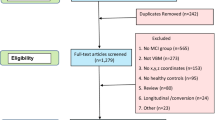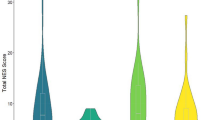Abstract
Previous studies have shown inconsistent results when reporting brain abnormalities in Williams syndrome (WS). This makes an interpretation of clinical and behavioural data uncertain in terms of anatomical localization of brain tissue changes. In this study we employed voxel based morphometry to directly investigate the regional distribution of grey matter (GM) density as a function of individual neuropsychological profiles in individuals with WS. GM maps were regressed against the neuropsychological measures on which WS individuals performed worse than controls. Results showed an association between the regional GM density in the cerebellum, bilaterally, the right Supplementary Motor Area, the right fusiform gyrus, and measures of morpho-syntactic ability. An association was also found between measures of visuo-spatial and visuo-motor abilities and regional GM density in the left cerebellum, left parietal lobule, right superior and left orbital frontal gyri. The study shows the potential to clarify the anatomical substrate underlying specific cognitive deficits in WS.



Similar content being viewed by others
References
Amarenco P, Chevrier-Muller C, Roullet E, Bousser MG (1991) Paravermal infarct and isolated cerebellar dysarthria. Ann Neurol 30:211–213
Ashburner J, Friston KJ (2005) Unified segmentation. Neuroimage 26:839–851
Atkinson J, Anker S, Braddick O, Nokes L, Mason A, Braddick F (2001) Visual and visuospatial development in young children with Williams syndrome. Dev Med Child Neurol 43:330–337
Beery KE (2000) VMI: Developmental test of visual-motor integration. Italian adaptation. Organizzazioni Speciali, Firenze
Bellugi U, Lichtenberger L, Jones W, Lai Z, St George M (2000) The neurocognitive profile of Williams syndrome: a complex pattern of strengths and weaknesses. J Cogn Neurosci 12(suppl 1):7–29
Blakemore SJ, Burnett S, Dahl RE (2010) The role of puberty in the developing adolescent brain. Hum Brain Mapp 31(6):926–933
Bozzo MT, Mansueto Zecca G (1993) Stanford-Binet intelligence scale (Form L-M)—Revised. Italian adaptation. Organizzazioni Speciali, Firenze
Campbell LE, Dalya E, Toalc F, Stevensa A, Azuma R, Karmiloff-Smithd A, Murphy DGM, Murphy KC (2009) Brain structural differences associated with the behavioural phenotype in children with Williams syndrome. Brain Res 1258:96–107
Colby CL, Goldberg ME (1999) Space and attention in parietal cortex. Annu Rev Neurosci 22:319–349
Devescovi A, Caselli MC (2001) Una prova di ripetizione di frasi per la valutazione del primo sviluppo grammaticale. Psicologia Clinica dello Sviluppo 3:341–364
Eckert MA, Hu D, Eliez S, Bellugi U, Galaburda A, Korenberg J, Mills D, Reiss AL (2005) Evidence for superior parietal impairment in Williams syndrome. Neurology 64:152–153
Eckert MA, Galaburda AM, Karchemskiy A, Liang A, Thompson P, Dutton RA, Lee AD, Bellugi U, Korenberg JR, Mills D, Rose FE, Reiss AL (2006a) Anomalous sylvian fissure morphology in Williams syndrome. Neuroimage 33:39–45
Eckert MA, Tenforde A, Galaburda AM, Bellugi U, Korenberg JR, Mills D, Reiss AL (2006b) To modulate or not to modulate: differing results in uniquely shaped Williams syndrome brains. Neuroimage 32:1001–1007
Fabbro F (2000) Introduction to language and cerebellum. J Neurolinguistics 13:83–94
Galaburda AM, Holinger DP, Bellugi U, Sherman GF (2002) Williams Syndrome: neuronal size and neuronal-packing density. Arch Neurol 59:1461–1467
Galati G, Committeri G, Sanes JN, Pizzamiglio L (2001) Spatial coding of visual and somatic sensory information in body-centred coordinates. Eur J Neurosci 14:737–746
George MS, Kutas M, Martinez A, Sereno MI (1999) Semantic integration in reading: engagement of the right hemisphere during discourse processing. Brain 122:1317–1325
Gosh A, Stading G, Pankau R (1994) Linguistic abilities in children with Williams-Beuren syndrome. Am J Med Genet 52:291–296
Holinger DP, Bellugi U, Mills DL, Korenberg JR, Reiss AL, Sherman GF, Galaburda AM (2005) Relative sparing of primary auditory cortex in Williams syndrome. Brain Res 1037:35–42
Karmiloff-Smith A, Brown JH, Grice S, Paterson S (2003) Dethroning the myth: cognitive dissociations and innate modularity in Williams syndrome. Dev Neuropsychol 23:227–242
Korenberg JR, Chen XN, Hirota H, Lai Z, Bellugi U, Burian D, Roe B, Matsoka R (2000) Genome structure and cognitive map of Williams syndrome. J Cogn Neurosci 12(suppl 1):89–107
Lacquaniti F, Perani D, Guigon E, Bettinardi V, Carrozzo M, Grassi F, Rossetti Y, Fazio F (1997) Visuomotor transformations for reaching to memorized targets: a PET study. Neuroimage 5:129–146
Lechtemberg R, Gilman S (1978) Speech disorders in cerebellar disease. Ann Neurol 3:285–290
Levitin DJ, Menon V, Schmitt JE, Eliez S, White CD, Glover GH, Kadis J, Korenberg JR, Bellugi U, Reiss AL (2003) Neural correlates of auditory perception in Williams Syndrome: an fMRI study. Neuroimage 18:74–82
Lupski JR, Stankiewicz P (2005) Genomic disorders: molecular mechanisms for rearrangements and conveyed phenotypes. PLoS Genet 1:e49
Marien P, Engelborghs S, Fabbro F, De Deyn PP (2001) The lateralized linguistic cerebellum: a review and a new hypothesis. Brain Lang 79:580–600
Marotta L, Trasciani M, Vicari S (2004) CMF. Valutazione delle competenze metafonologiche. Erickson, Trento
Martens MA, Wilson SJ, Reutens DC (2008) Research Review: Williams syndrome: a critical review of the cognitive, behavioral, and neuroanatomical phenotype. J Child Psychol Psychiatry 49:576–608
Mesulam MM (1999) Spatial attention and neglect: parietal, frontal and cingulate contributions to the mental representation and attentional targeting of salient extrapersonal events. Philos Trans R Soc Lond B Biol Sci 354:1325–1346
Meyer-Lindenberg A, Kohn P, Mervis CB, Kippenhan JS, Olsen RK, Morris CA, Berman KF (2004) Neural basis of genetically determined visuospatial construction deficit in Williams syndrome. Neuron 43:623–631
Myers PS (1999) Discourse deficits. In: Myers PS (ed) Right hemisphere damage. Singular Publishing Group, San Diego, pp 101–134
Myers PS, Brookeshire RH (1996) Effect of visual and inferential variables on scene descriptions by right-hemisphere damaged and non-brain damaged adults. J Speech Hear Res 39:870–880
Orsini A (1993) Wechsler intelligence scale for children—revised. Italian adaptation. Organizzazioni Speciali, Firenze
Orsini A, Grossi D, Capitani E, Laiacona M, Papagno C, Vallar G (1987) Verbal and spatial immediate memory span: Normative data from 1355 adults and 1112 children. Ital J Neurol Sci 8(6):539–548
Porter MA, Coltheart M (2005) Cognitive heterogeneity in Williams syndrome. Dev Neuropsychol 27:275–306
Porter MA, Coltheart M (2006) Global and local processing in Williams syndrome, autism, and down syndrome: perception, attention, and construction. Dev Neuropsychol 30:771–789
Reiss A, Eckert MA, Rose FE, Karchemskiy A, Kesler S, Chang M, Reynolds MF, Kwon H, Galaburda A (2004) An experiment of nature: brain anatomy parallels cognition and behavior in Williams syndrome. J Neurosci 24:5009–5015
Riva D, Giorgi C (2000) The cerebellum contributes to higher functions during development: evidence from a series of children surgically treated for posterior fossa tumours. Brain 123:1051–1061
Riva D, Nichelli F, Devoti M (2000) Developmental aspects of verbal fluency and confrontation naming in children. Brain Lang 71:267–284
Rizzolatti G, Fogassi L, Gallese V (1997) Parietal cortex: from sight to action. Curr Opin Neurobiol 7:562–567
Robertson DA, Gernsbacher MA, Guidotti SJ, Robertson RR, Irwin W, Mock BJ, Campana ME (2000) Functional neuroanatomy of the cognitive process of mapping during discourse comprehension. Psychol Sci 11:255–260
Rustioni D (1994) Prove di valutazione della comprensione linguistica. Organizzazioni Speciali, Firenze
Schmitt JE, Eliez S, Bellugi U, Reiss AL (2001) Analysis of cerebral shape in Williams syndrome. Arch Neurol 58:283–287
Sekiyama K, Miyauchi S, Imaruoka T, Egusa H, Tashiro T (2000) Body image as a visuomotor transformation device revealed in adaptation to reversed vision. Nature 407:374–377
Stella G, Pizzoli C, Tressoldi P (2000) Peabody picture vocabulary test. Italian adaptation. Omega Edizioni, Torino
Tavano A, Grasso R, Gagliardi C, Triulzi F, Bresolin N, Fabbro F, Borgatti R (2007) Disorders of cognitive and affective development in cerebellar malformations. Brain 130:2646–2660
Tomaiuolo F, Di Paola M, Caravale B, Vicari S, Petrides M, Caltagirone C (2002) Morphology and morphometry of the corpus callosum in Williams syndrome: a magnetic resonance imaging analysis. Neuroreport 13:1–5
Vicari S, Bates E, Caselli MC, Pasqualetti P, Gagliardi C, Tonucci F, Volterra V (2004) Neuropsychological profile of Italians with Williams syndrome: an example of a dissociation between language and cognition? J Int Neuropsychol Soc 10:862–876
Vicari S, Verucci L, Carlesimo GA (2007) Implicit memory is independent from IQ and age but not from etiology: evidence from Down and Williams syndromes. J Intellect Disabil Res 51:932–941
Wilke M, Lidzba K (2007) LI-tool: a new toolbox to assess lateralization in functional MR-data. J Neurosci Methods 163:128–136
Acknowledgments
D.M. gratefully acknowledges financial support from the Jerome Lejeune Foundation.
Author information
Authors and Affiliations
Corresponding author
Additional information
Edited by Pierre Roubertoux and Petrus de Vries.
Rights and permissions
About this article
Cite this article
Menghini, D., Di Paola, M., Federico, F. et al. Relationship Between Brain Abnormalities and Cognitive Profile in Williams Syndrome. Behav Genet 41, 394–402 (2011). https://doi.org/10.1007/s10519-010-9419-0
Received:
Accepted:
Published:
Issue Date:
DOI: https://doi.org/10.1007/s10519-010-9419-0




